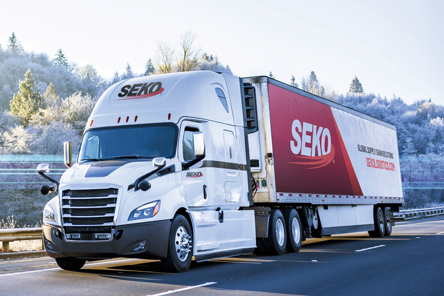The logistics landscape has evolved rapidly, especially with the rise of ecommerce, omnichannel retail, and global sourcing. Businesses today must decide not only how to manage logistics but who should manage it, and to what extent. That’s where the 3PL vs 4PL discussion becomes critical. By understanding the roles of third-party and fourth-party logistics providers, companies can confidently move toward a logistics solution that supports scale, cost-efficiency, and customer satisfaction.
Enter third-party logistics (3PL) and fourth-party logistics (4PL) providers—your keys to building a streamlined and efficient supply chain. But how do you choose between the two?
In this article, we'll dive deep into the world of 3PLs and 4PLs, demystifying their roles, responsibilities, and differences to help you make the right choice for your business.
WHAT IS A THIRD-PARTY LOGISTICS PROVIDER (3PL)?
A third-party logistics provider (3PL) is a company that manages outsourced logistics services such as transportation, warehousing, inventory management, order fulfillment, and returns. These providers serve as intermediaries between your business and the carriers responsible for delivering goods to your customers.
3PLs are a strong fit for companies that want to streamline their logistics operations without building in-house capabilities. By partnering with a 3PL, businesses can focus on core functions like sales and customer experience while relying on logistics experts to handle the physical movement of goods.
To learn more about 3PLs, read our previous article: 3PL vs. In-house: What’s the Difference.
-
3PL Management: Oversee and coordinate the activities of multiple logistics providers.
-
Optimize Operations: Continuously identify areas to reduce costs and improve performance.
-
Coordinate Services: Ensure seamless collaboration across the supply chain.
-
Integrate Technologies: Implement advanced platforms to unify data, tracking, and communication.
-
Supply Chain Strategy: Develop logistics plans that align with business goals.
-
Data Governance: Maintain control and visibility over KPIs, compliance metrics, and reporting.
-
Risk Mitigation: Identify and resolve potential disruptions across global operations.
WHAT IS A FOURTH-PARTY LOGISTICS PROVIDER (4PL)?
A fourth-party logistics provider (4PL) is a logistics partner that takes on a higher level of supply chain management compared to third-party logistics providers (3PL). A 4PL company oversees and coordinates the entire supply chain process, including managing 3PLs, optimizing operations, integrating technologies, and providing end-to-end logistics solutions.
Unlike 3PLs, 4PLs rarely own physical assets like trucks or warehouses. Instead, they specialize in strategic supply chain oversight, often managing multiple 3PLs and technology platforms simultaneously.
WHAT ARE THE RESPONSIBILITIES OF A 4PL?
To make an informed decision about which logistics provider is best for your business, it’s essential to understand the roles and responsibilities of a 4PL (fourth-party logistics) company. From managing 3PLs to coordinating your entire supply chain, 4PLs can revolutionize your logistics operations.
WHAT IS THE DIFFERENCE BETWEEN 3PL AND 4PL?
Navigating the logistics landscape can be challenging, especially when distinguishing between the unique services and roles of 3PLs and 4PLs in supply chain management. There are some key differences between 3PLs and 4PLs, ranging from areas of focus to their distinct operational approach. With a solid understanding of these differences, you can choose which provider best aligns with your needs and growth objectives.
Many companies begin with a 3PL to handle tactical logistics but may evolve into a 4PL partnership as operations grow more complex. Understanding these distinctions helps you decide which model fits your goals today, and which may serve you in the future.
|
3PLs |
4PLs |
|
|
Order Fulfillment |
3PLs handle the physical movement of goods |
4PLs manage the entire fulfillment process, including coordinating with 3PLs |
|
Supply Chain Optimization |
3PLs focus on specific logistics functions |
4PLs develop comprehensive supply chain strategies |
|
Communications |
3PLs’ communication mainly revolves around their individual logistics services |
4PLs act as a single point of contact for all supply chain activities, streamlining communication between various logistics partners |
|
Areas of Focus |
3PLs specialize in specific logistics services, such as warehousing, transportation, and order fulfillment |
4PLs offer end-to-end supply chain management solutions |
|
Relationships |
3PLs’ relationships are often more transactional, concentrating on ensuring efficient execution of the agreed-upon tasks |
4PLs often have stronger, long-term partnerships with clients, 3PLs and other logistics providers |
|
Resources |
3PLs typically own physical assets, like trucks and warehouses |
4PLs rely on their strategic management capabilities |
HOW DOES THE 4PL PROCESS DIFFER FROM A 3PL?
A 3PL's process mainly focuses on the execution of specific logistics operations. They provide the assets and infrastructure necessary to move products efficiently within the supply chain.
On the other hand, a 4PL's process takes a more strategic approach, overseeing and managing the entire supply chain. They optimize your logistics operations by leveraging advanced technology, data analysis, and supply chain engineering to improve end-to-end performance.
While 3PLs focus on the hands-on execution of logistics services, 4PLs operate at a higher level by managing the broader supply chain. The breakdowns below illustrate the difference between tactical execution and strategic oversight. Understanding these roles can help you decide which model aligns better with your operational goals.
THE 3PL PROCESS:
- RECEIVING INVENTORY: Accept shipments from suppliers and confirm the accuracy of delivered goods.
- WAREHOUSING: Store products in an organized and efficient manner to ensure easy access and retrieval.
- INVENTORY MANAGEMENT: Track product levels, monitor stock movements, and maintain accurate records for inventory control.
- ORDER PROCESSING: Receive, process, and prepare customer orders for shipping.
- SHIPPING: Coordinate with carriers, arrange transportation, and ship products to customers according to required delivery times.
- RETURNS MANAGEMENT: Handle product returns, process refunds, and manage reverse logistics to get products back into inventory or dispose of them.
- REPORTING & ANALYTICS: Provide data and insights on warehouse operations, inventory, and order fulfillment performance to help clients make informed decisions.
This model is ideal for businesses that want operational support but still prefer to maintain direct involvement in vendor relationships and logistics decisions.
THE 4PL PROCESS:
-
STRATEGY DEVELOPMENT: Analyze logistics requirements and develop a tailored strategy to optimize supply chain performance.
-
PROVIDER SELECTION: Identify, select, and manage the best-suited 3PLs and other service providers to ensure efficient operations.
-
INTEGRATION & COORDINATION: Synchronize and oversee all logistics activities across multiple providers for streamlined execution.
-
TECHNOLOGY IMPLEMENTATION: Deploy and manage advanced technology systems to enable real-time visibility, communication, and analytics.
-
SUPPLY CHAIN OPTIMIZATION: Continuously assess and improve logistics processes, identify bottlenecks, and implement cost-effective measures.
-
PERFORMANCE MANAGEMENT: Monitor key performance indicators (KPIs) and provide data-driven insights to clients for informed decision-making.
-
COLLABORATION & INNOVATION: Work closely with you and logistics partners to drive continuous improvements and innovation in the supply chain.
A 4PL model is best suited for organizations managing complex supply chains that require long-term scalability, centralized strategy, and coordination across multiple providers.
HOW DO 4PLS AND 3PLS WORK TOGETHER?
3PLs and 4PLs collaborate to deliver an end-to-end supply chain solution. The 4PL acts as a strategic orchestrator, managing the entire supply chain and coordinating the logistics functions performed by 3PLs. With modern logistics technology, integration between 3PLs and 4PLs has become more seamless than ever. Through shared data platforms, real-time visibility tools, and cloud-based dashboards, 4PLs can coordinate multiple 3PLs across regions while maintaining centralized oversight. This collaboration allows businesses to benefit from the efficiency of specialized 3PL services, while also gaining strategic alignment, consistency, and performance optimization across their entire logistics network.
The 4PL offers guidance and support to 3PLs to enhance their performance and streamline their processes. In this partnership, the 4PL and 3PL play vital roles, with the 4PL focusing on strategic oversight and integration while the 3PL executes specific logistics services. This collaborative partnership ensures a well-managed and high-performing supply chain.
3PL VS 4PL: WHICH IS RIGHT FOR YOUR BUSINESS?
Choosing between a 3PL or 4PL provider for your business involves assessing various factors that influence your supply chain’s efficiency. We’ve created a list of key factors you should consider to help you determine which logistics provider best aligns with your company’s needs and objectives.
KEY FACTORS TO CONSIDER:
-
BUSINESS SIZE & COMPLEXITY: Smaller businesses with less complex supply chains may benefit more from 3PL partners. Enterprise-level businesses with intricate supply chains may require the comprehensive management offered by 4PL partners.
-
CONTROL & INVOLVEMENT: If you want to maintain more control and direct involvement in your supply chain management, a 3PL partner may be a better choice. On the other hand, if you prefer to delegate logistics operations to an outside expert, a 4PL partner may be more suitable.
-
SCALABILITY: If your business anticipates significant growth in the future, partnering with a 3PL may provide more flexibility to adapt to changes. 4PLs may offer better solutions for businesses that need comprehensive management and coordination across multiple 3PLs.
-
COST: Typically, 4PL partners charge a premium for their services due to their expertise and the more extensive range of responsibilities they undertake. Consider your budget and the potential return on investment when deciding between a 3PL or 4PL partner.
-
INTEGRATION OF TECHNOLOGY: 4PLs typically implement centralized dashboards that consolidate vendor data, optimize route planning, and provide predictive analytics. Their ability to unify siloed systems is key for growing companies needing cross-platform supply chain visibility.
Read Dell EMC’s case study to learn how SEKO integrated global technology with its unique Transport Management System.
-
GEOGRAPHIC REACH: Depending on the scope of your business, it’s essential to consider the geographic reach of your potential logistics partner. Some 3PLs may be more regional, while 4PLs usually offer global coordination and management.
-
RANGE OF SERVICES: 3PLs generally provide targeted services like transport, warehousing, and completing orders. In contrast, 4PLs manage a more extensive array of services, encompassing the supervision of multiple 3PLs, comprehensive supply chain enhancement, and orchestration of diverse logistics functions.
HOW SEKO CAN HELP
SEKO is a leading 3PL partner that offers comprehensive logistics services tailored to your specific needs, including transportation, warehousing, order fulfillment, and end-to-end supply chain management solutions.
With a 45-year proven track record of success, we have helped countless businesses streamline their supply chain operations through advanced technology integration, global coverage, and scalable services.
Trust an award-winning logistics provider to handle your needs and watch your business thrive with our customized, efficient, and reliable solutions. Ready to explore what SEKO can do for you? Schedule a call with our logistics experts today!
Frequently Asked Questions Around 3PL VS. 4PL
1. What is the difference between 3PL and 4PL logistics?
A 3PL handles logistics execution (like warehousing or shipping), while a 4PL manages the entire supply chain, including oversight of 3PLs and data systems.
2. Can a 3PL become a 4PL?
Some 3PLs may offer expanded strategic services, but a true 4PL acts as an independent integrator, not just a service provider.
3. When should a business switch from 3PL to 4PL?
Consider switching when you're managing multiple logistics vendors or require a single point of control for supply chain strategy, performance, and technology.
4. Is a 4PL more expensive than a 3PL?
4PLs usually charge more due to their broader responsibilities, but they often deliver higher ROI through optimization and efficiency gains.
5. Do 4PLs use their own trucks or warehouses?
No, most 4PLs do not own physical assets. They operate as logistics architects, managing other service providers on your behalf.



